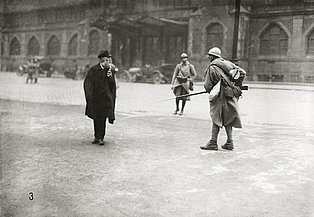
Hyperinflation, violence, economic standstill and abject poverty: the Ruhr occupation not only stands for an exceptional situation, but is a central chapter in the history of the Ruhr region. On the occasion of the 100th anniversary of the beginning of the Ruhr occupation, the gallery exhibition of the Ruhr Museum presents the everyday life of the occupationfrom 1923 to 1925, showing the experiences of the population and the occupiers as well as the events of these crisis years in six chapters. In doing so, it also sheds light on the moment in history when the Ruhr emerged as a unified region and important foundations were laid for the Metropole Ruhr as an area of identification.
In addition to rare film footage , around 200 impressive exhib its such as photographs, postcards, flyers, posters, identity cards and other documents, as well as medals, commemorative plaques, weapons and uniforms depict everyday life in the occupation from different perspectives. Particularly impressive objects come from major European museums, such as a rare shooting target from the German Historical Museum in Berlinuniforms and equipment of French and Belgian occupation soldiers from the Musée de la Grande Guerre du Pays de Meaux in France and an original machine gun from the Musée Royal de l'Armée et d'Histoire Militaire in Brussels, Belgium.
The exhibition spans the period from the invasion of the troops in January 1923 to the celebrations marking the withdrawal in 1925. The occupation authorities intervened massively in people's lives with countless decrees and measures. Border barriers were erected between the occupied and unoccupied territories, making people's daily lives much more difficult. In addition, there were arbitrary curfews, road controls and quartering. Some 130 civilians died in accidents and assaults by occupying soldiers.
The refusal to cooperate presented the French with considerable challenges, especially in the transportation sector. For example, they had to implement a railroad under their own direction within a short period of time, which led to numerous accidents and disruptions due to the complexity of the track system. The French and Belgian soldiers also found themselves in a difficult situation. They faced a predominantly hostile population and lived in fear of becoming victims of assassination. Supply and housing were often inadequate.
Passive resistance financed by the Ruhr industry and the Reich completely ruined the German currency. Hyperinflation led to the complete impoverishment of large sections of the population, and unemployment reached unprecedented levels. In many places, material hardship led to social unrest that threatened social cohesion.
In addition, the exhibition shows the propaganda war for public opinion, documented in mass-published leaflets and in sometimes racist posters.
The exhibition concludes with the withdrawal of the troops and the commemorative culture that the Ruhr occupation set in motion, especially in the run-up to the Nazi seizure of power.
The signing of the Versailles Peace Treaty on June 28, 1919, marked the end of the "Great War" (1914-1918) under international law. Germany had lost this war and was obliged by the Allies to pay reparations.
Because the German side had defaulted on the reparations, French and Belgian troops occupied the area in January 1923. The German population was fascinated by this economically and strategically important region.
The occupation of the Ruhr marked the beginning of a year of crisis, characterized by inflation, attempted coup d'états, violence, poverty and unemployment. The invasion of the Ruhr in the midst of peace had the characteristics of a wartime occupation: around 60,000 French and Belgians entered the cities of the Ruhr with tanks, infantry, cavalry, bicycle and machine-gun units.
The invasion took place in a deeply torn and divided Ruhr region, which had already been marked by existential hardships and experiences of violence for almost a decade. The Franco-Belgian occupation thus took place in a permanently exceptional situation and brought the region, which had been so prosperous in the 19th century, to the limits of its economic and social resilience.
Immediately after the occupation began, the German government declared passive resistance and stopped all reparations payments. All cooperation with the occupiers was to cease. The occupiers' countermeasures, such as curfews, arrests and expulsions to unoccupied territory, were not long in coming. Bloody clashes between soldiers and the population were the order of the day, and a spiral of violence was set in motion. Although the occupation of the Ruhr ended in the summer of 1925with the withdrawal of the occupying troops, it was to prove a heavy burden for the young republic.
The catalog accompanying the exhibition "Hands off the Ruhr! Die Ruhrbesetzung1923-1925" presents on 212 pages in eleven richly illustrated articles the most important phenomena of the Ruhr occupation from different perspectives. The catalog is published by Klartext Verlag, costs €24.95 and is also available in our store on the 24-meter level. You can find the opening hours here.
ISBN 978-3-8375-2555-7
The Regionalverband Ruhr (RVR) is sponsoring the exhibition and the accompanying program.
Three years after the founding of the Ruhr Coal District Settlement Association in May 1920, the forerunner of the RVR, the Ruhr occupation also meant a boost for the unification of the Ruhr region. This was because it brought the region into the public consciousness for the first time across party lines, both internally and in terms of national and international perception. As the Ruhr Association of Municipalities and today's Ruhr Regional Association, the association has been the region's bracket for more than a century. Since then, the well-being of the Metropole Ruhr has been at the center of the RVR's legal mandate - as a networker, coordinator, initiator, service provider or project sponsor. The Ruhr Parliament, directly elected for the first time in the anniversary year 2020, is the political representation for the Ruhr region.
The association on the web: www.rvr.ruhr
Further information on the exhibition and the extensive accompanying program can be found here as PDFs for download:
Share